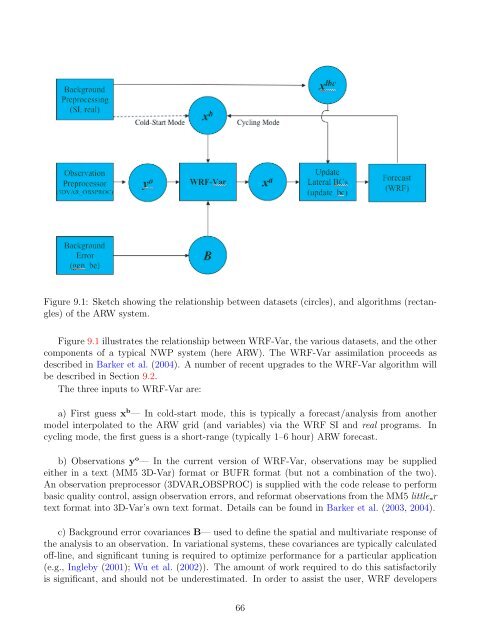Advanced Research WRF (ARW) Technical Note - MMM - University ...
Advanced Research WRF (ARW) Technical Note - MMM - University ...
Advanced Research WRF (ARW) Technical Note - MMM - University ...
You also want an ePaper? Increase the reach of your titles
YUMPU automatically turns print PDFs into web optimized ePapers that Google loves.
Figure 9.1: Sketch showing the relationship between datasets (circles), and algorithms (rectangles)<br />
of the <strong>ARW</strong> system.<br />
Figure 9.1 illustrates the relationship between <strong>WRF</strong>-Var, the various datasets, and the other<br />
components of a typical NWP system (here <strong>ARW</strong>). The <strong>WRF</strong>-Var assimilation proceeds as<br />
described in Barker et al. (2004). A number of recent upgrades to the <strong>WRF</strong>-Var algorithm will<br />
be described in Section 9.2.<br />
The three inputs to <strong>WRF</strong>-Var are:<br />
a) First guess x b — In cold-start mode, this is typically a forecast/analysis from another<br />
model interpolated to the <strong>ARW</strong> grid (and variables) via the <strong>WRF</strong> SI and real programs. In<br />
cycling mode, the first guess is a short-range (typically 1–6 hour) <strong>ARW</strong> forecast.<br />
b) Observations y o — In the current version of <strong>WRF</strong>-Var, observations may be supplied<br />
either in a text (MM5 3D-Var) format or BUFR format (but not a combination of the two).<br />
An observation preprocessor (3DVAR OBSPROC) is supplied with the code release to perform<br />
basic quality control, assign observation errors, and reformat observations from the MM5 little r<br />
text format into 3D-Var’s own text format. Details can be found in Barker et al. (2003, 2004).<br />
c) Background error covariances B— used to define the spatial and multivariate response of<br />
the analysis to an observation. In variational systems, these covariances are typically calculated<br />
off-line, and significant tuning is required to optimize performance for a particular application<br />
(e.g., Ingleby (2001); Wu et al. (2002)). The amount of work required to do this satisfactorily<br />
is significant, and should not be underestimated. In order to assist the user, <strong>WRF</strong> developers<br />
66
















